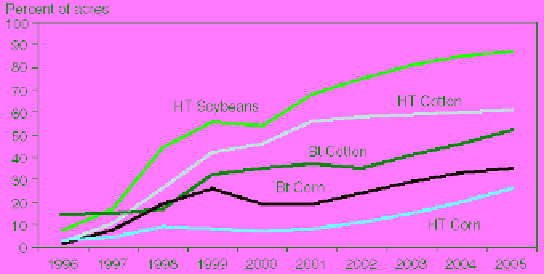Agriculture Reference
In-Depth Information
A
DOPTION OF
GE
C
ROPS BY
U.S.
F
ARMERS
I
NCREASES
S
TEADILY
Farmers are more likely to adopt new practices and technologies if they
expect to benefit from them. Benefits are usually thought of in monetary
terms, but can also include ease of operation, time savings, lower exposure to
chemicals, and other factors. Farmers choose technologies and practices they
expect to yield the greatest benefit based on their own preferences, farm
characteristics, demand for their product, and costs.
Farmers' expectations of higher yields, savings in management time, and
lower pesticide costs have driven a rapid increase in the adoption of GE crop
varieties in the United States and several other countries. An estimated 200
million acres of GE crops with herbicide tolerance and/or insect resistance
traits were cultivated in 17 countries worldwide in 2004, a 20-percent increase
over 2003. U.S. acreage accounts for 59 percent of this amount, followed by
Argentina (20 percent), Canada and Brazil (6 percent each), and China (5
percent) (ISAAA, 2004).
3
GE varieties of soybeans, corn, and cotton have been available commer-
cially in the United States since 1996, and the rate of adoption by U.S. farmers
has climbed in most years since then (figure 6). For the most part, farmers
have adopted herbicide-tolerant (HT) varieties—which help control weeds by
enabling crops to survive certain herbicides that previously would have
destroyed them along with the targeted weeds—at a faster pace than insect-
resistant (Bt) varieties.
*
Data for each crop category include varieties with both HT and Bt (stacked) traits.
Source: Fernandez-Cornejo (2005).
Figure 6. Adoption of genetically engineered crops grows steadily in the U.S.
*


